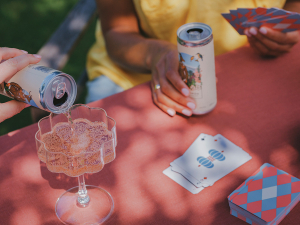The first canned wines were released in the United States in the 1930s, and since then, various iterations of canned wine products have appeared and disappeared from our shelves. It now looks like canned wine is here to stay, with the format seeing increasing popularity, especially in the US, but also the United Kingdom and Australia.
In 2021 the global canned wine market was worth $USD235.7m and is estimated to surpass $USD570m by 2028. According to a report by ‘Research and Markets’ out of Australia, canned wine in Australia is expected to show annual growth of 5-10% over the next five years. The report showed this growth has been fuelled mainly by millennials and Gen Xers.
In the early days, it was the convenience, quick chilling and individual serving size of canned wine that gave it a boost. But recently, it is the environmental advantages of canned wine that are fuelling much of the growth. The carbon footprint per litre (CO2e/L) of wine in a can is 70% less than in lightweight glass bottles. According to the Packaging Council of New Zealand, just like glass, aluminium is 100% recyclable, but unlike glass, recycling aluminium requires only 5% of the energy and produces only 5% of the CO2 emissions compared with primary production.
However, canned wine still faces several barriers, including quality perceptions by consumers and trade, shelf-life limitations, and resistance in traditional wine markets. One of the early challenges to canned wine was concerns over quality, with some wines plagued with sulphide aroma issues. A research project at the Australian Wine Research Institute (AWRI) has been looking at understanding and mitigating the development of reductive characters in canned wine.
So far, the study has shown high levels of copper and chloride in a wine can increase the chance of pitting in the internal surface coating of the can. If this protective barrier is corroded, there is potential for aluminium transfer into the wine. This aluminium can then react with sulphur dioxide (SO2) in the wine to form hydrogen sulfide (H2S) in a pathway which doesn’t exist in glass bottle wines. The study highlighted the need for selecting wines suitable for canning and understanding and mitigating the main risk factors – wine pH, along with Copper, SO2 and Chloride concentrations.
One company that has launched wine in can both in the UK and New Zealand markets is The Uncommon. While living in the UK, Hannah Sweeney worked with The Uncommon Wine of England – a startup wine brand putting local UK sparkling wines (mainly Pinot Noir and Bacchus) in cans. In 2021 she returned to New Zealand and saw a gap in the market. “I noticed the trend of craft beer and RTDs in cans, but being a wine lover, I felt a little left out”. She joined forces with the UK team and with her co-founder Anna Campbell, set about to create The Uncommon Wine of New Zealand. Currently, they have a single vineyard Sauvignon Blanc and a Pinot Noir Rosé in can.
While the team at The Uncommon saw the US market embracing canned wine since the early ‘noughties’, they found the stigma attached to wine in cans in UK and New Zealand a bit harder to shake. In 2018, when they first launched in the UK “they were laughed out of many rooms”, Hannah says. “It’s pretty, but our premium customers won’t drink wine out of a can.” They have slowly but surely seen a change. “We’ve witnessed first-hand the shift in consumer perception and the market evolve in the UK, and we’re confident we will see the same in New Zealand.”
She believes this change in perception is driven primarily by three factors: improvements in quality, increased awareness in sustainability, and changing consumer lifestyles. “Just as we’ve already witnessed with the craft beer, RTD, and canned cocktail movement – so the shift is happening. For some reason, wine still clings to unnecessary tradition.”
Their key market leans female, but Hannah says they are linked by interest and affinity rather than demographic. She says they are interested in nature, local products, and sustainability, but have a surprisingly broad age range, from 25-60. Hannah has seen more people wanting to make a sustainable choice. “79% of CO2 emissions could be cut from switching a 75cl glass bottle to three 250ml aluminium cans. The can also chills fast, is lighter to transport, and is more easily and endlessly recyclable.”
She doesn’t see the can replacing the wine bottle and says there will always be occasions where the bottle will reign supreme. But she sees cans sitting alongside bottles and offering consumers choice, especially younger drinkers. “It goes where no glass bottle has (successfully) gone before – al fresco gatherings, picnics in the park, beach strolls, hiking, boating, camping, etc. and appeals to the younger more mobile consumer of wine. One the global wine trade is desperately trying to attract."
And what about the quality concerns? “Excellent wine not only survives but thrives in cans,” Hannah says. “We have a double lining to ensure no liquid touches the aluminium. The quality of the wine itself is no different to what you would find in a glass bottle.”










